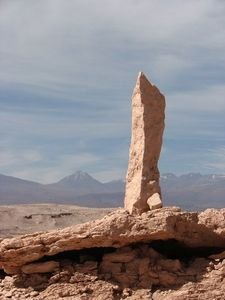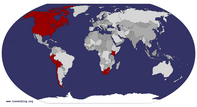Advertisement
Published: November 14th 2007

 Atacama Desert
Atacama Desert
Auf dem Weg zum Valle de LunaNachdem wir (Marijn und ich) uns in San Pedro de Atacama ein wenig erholt und den völkerwandrungsmässig besuchten Sonnenuntergang im Valle de luna angeschaut hatten machten wir uns auf den Weg nach Calama. Wenig nördlich davon liegt Chuquicamata, eine Arbeiterstadt welche bald nicht mehr existieren wird da sie der weltgrössten Kupfermine im Tagabbau platz machen muss. Die ist gigantische 4km breit, 5km lang und 1km tief, jährlich werden ca. 700'000 Tonnen Kupfer gewonnen. Die riesigen Laster welche das Gestein aus der Mine transportieren wirken gegen die sie beladenden Bagger klein, und beide werden dabei von einer dichten Staubwolke eingehüllt. Leider war hier auch schon das Ende der gemeinsamen Reise mit Marijn da sie in den Norden von Chile zurück nach Bolivien und ich südlich nach Santiago halten musste. Nach einem Zwischenstopp in Antafogasta erreichte ich Chanaral um mir von da aus in den Parque National Pan de Azucar anzusehen. Er liegt am südwestlichen Rand der Atacama-Wüste; die trockenste Wüste der Welt. Hier hat es wegen dem fischreichen, aber kalten Humboldt-Strom vor der Küste nur wenig Niederschlag. Im Park selber hat es seit 10 Jahren nicht mehr geregnet, was vorher allerdings etwa alle 3 Jahre mal der Fall war. Klimaveränderung wo man

 Atacama Desert
Atacama Desert
Auf dem Weg zum Valle de Lunahingeht... Es gibt aber ausser den Kaktussen noch mehr Pflanzen welche der Trockenheit widerstehen können. Zum baden ist es zu kalt, aber die Aussicht ist hammer! Ebenfalls hier sah ich meine ersten Pelikane in freier Wildbahn.
Weiter gings im Nachtbus nach Vina del Mar, welches nur 2 Busstunden von Santiago entfern an der Küste liegt. Füsse strecken, das grün der Pflanzen und das Meer geniessen, gut essen. Dann nach Santiago, wieder mal eine Grosstadt. Ich hatte mich schon beinahe an die höheren Preise in Chile (im Vergleich zu Peru/Bolivien) gwohnt, aber hier war alles nochmals ein wenig teurer. Dafür gibt es in Chile wieder geteerte Strassen (eine richtige Wohltat nach all den Dreckpisten in Bolivien), Notabgänge auf lang abfallenden Strecken, in den Dörfern ist nicht nur die Hauptstrasse geteert, Kühlschränke sind keine seltenheit mehr resp. sind auch eingeschaltet und das WC-Papier wird wieder häufiger zur Verfügung gestellt.
Schon bald ging mein Flug nach den Osterinseln wo die Preise nochmals anstiegen. Ich mietete einen Scooter und erkundete so die Insel mit ihren Ahus, so werden die Steinfiguren genannt. Nach dem Sonnenuntergang ging ich tanken, zurück ins Hostel und wollte die Batterien der Kamera aufladen. Shock. Die Tasche war weg! Ich hatte
sie wie immer mit dem Klettverschluss aussen am Rucksack befestigt gehabt, aber offensichtlich hatte die Rüttele des Tages dem mehr zugesetzt als er vertrug, gemerkt habe ich auch nichts. Bin dann 2mal die Strecke abgefahren, habe an der Tankstelle nachgefragt. Nichts. Zum Glück hatte ich am Morgen noch die Bilder auf DVD gebrannt. Habe mich mit Bier getröstet und ging am nächsten Tag zum Inselradio da es kein Fundbüro gibt. Die halfen mir sehr liebenswürdiug und sendeten eine Vermisstanzeige. Und tatsächlich meldete sich der ehrliche Finder! Rieeesen Schwein gehabt...
Ich lernte per Zufall Josef (
seine Website), einen Schweizer welcher schon seit 17 Jahren hier lebt kennen welcher mir einige interessante Dinge über die Insel erzählte welche man sonst kaum mitbekommt. Sie wirkt zwar friedlich, aber der Schein trügt. Etwa die Hälfte der Einwohner sind Chilenen vom Festland. Für sie ist es finanziell sehr interessant auf der Insel zu leben, da die Leute welche hier leben keine Steuern zahlen, Schule und Spital sind gratis und da sie weit weg von Santiago sind verdienen sie auch noch mehr. Die Einwanderung der Chilenen hat das Leben hier stark verändert wie er mir er mir erklärte, die Insulaner mögen die Chilenen nicht und aus seiner
Sicht ist es ein Pulverfass, welches irgendwann explodieren wird. Nur die Insulaner sind berechtigt, Land zu besitzen. Also was nach Abzug des Nationalparks (der Grossteil der Insel) noch davon übrig bleibt. Der Staat finanziert dann auch noch das Haus darauf und so haben einige Insulaner gleich noch ein zweites gebaut, welches sie den eingewanderten Chilenen vermieten, welche sie ja eigentlich nicht mögen. Es geht wieder mal nur ums Geld...
Ab den Infos und plaudern vergass ich ganz, meine am Morgen aufgegebene Wäsche abzuholen und am nächsten Tag war Sonntag, die Wäscherei geschlossen und ich flog ab. Denise, die Frau von Josef, ist zum Glück auf Umwegen mit der Wäschereiinhaberin (Chilenin) verwandt (so wie alle hier hat man den Eindruck) und so kam ich nach einem Verhör mit nachfolgendem Zusammenschiss meine Kleider doch noch zurück. Die Touristen kommen hier schliesslich selten zurück...
After we (Marijn and I) had a rest in Sn Pedro de Atacama and watched the sunset at the famous and therefore crowded Valle de Luna we set off for Calama. A little further north of it is Chuquicamata. This is a city for workers in the nearby worlds biggest daylight copper mine and will not exist anymore

 Calama - Sonnenuntergang/Sunset
Calama - Sonnenuntergang/Sunset
Leider habe ich es nicht mehr rechtzeitig aus der Stadt heraus geschafft...
Unfortunately I didn't manage to get out of the town in time...prety soon because the mine needs to satisfy it's hunger for more copper that lies underneath the town. The mine is already gigantic 5km long, 3km wide, about 1km deep and they gain about 700'000 tons of copper per year out of it. The huge trucks that transport the stones out of the mine seem to be small against the diggers which loads 'em while both beeing covered in a huge cloud of dust. Unfortunately this was also the end of our common travel because she wanted to head north to go back to Bolivia and I needed to go south towards Santiago in order to catch my plane to the Easter Islands. After a stopover night in Antofagasta I went to Chanaral to see the Parque National Pan de Azucar which lies on the southwestern corner of the Atacama desert. It's the driest desert in the world because of the fishrich, but cold humboldt stream flowing in front of the coast there's only few precipitation. It hasn't rained here since ten years, although it used to rain about every 3 years before this period. The climate is changing here as well. But there are also some other plants beside
the cactuses. End even though it's to cold to have a swimm, the veiw over the sea is beautiful! Also here I saw my very first pelicans in the wild.
I then took the night bus to Vina del Mar which is on the coast, only 2 hours busride away from Santiago. There I streched my legs, enjoyed the sun and ate good. Then kept on moving to Santiago, once again a big city. I almost got used to the higher prices in Chile, but here everything was a little more expensive. But the good thing is that there are emergency exits on long steep downhill roads, not only the main roads in towns are sealed and toilet paper is provided more often in contrast to Bolivia. Pretty soon my plane took me to Easter Island, where the prices raised again. I rented a scooter and explored the island with it's Ahus (that's how the stone figures are called) with it. After enjoing the sunset I went to the gas station and back in the hostel I wanted to recharge th batteries of my camera. Shock. The bag was gone! I had it attached to the outside of my backpack

 Chuquicamata - Laster/Trucks
Chuquicamata - Laster/Trucks
Der Pickup sieht im Vergleich winzig aus :)
The pickup truck looks small in comparison :)with the velcro as many times before, but the shaky ride of the day obviously put it too hard on it. So I drove the hole strech two times again, asked at the gasstation. Nothing. Luckely I burned a DVD with all the pictures the very same morning. Made myself feel a little better with a couple of beers and went to the radio station of the island the next morning because there's no lost and found office. They helped me very friendly and broadcasted a announcement. And I was very lucky: The honest guy who found it turned in and I got it back! Huuuuge relief...
By coincidence I learned to know Josef (
his website), a swiss guy who lives on the island since 17 years and knew some interesting things to tell about the island which someone would barly recognize otherwise. The island seems to be very peaceful, but the appearances are deceiving. About half of the inhabitants are chileans from the mainland. For them it's financially very interesting to live here because the ones that live on the island do not pay taxes, schools and hospital are for free and because it's far away from Santiago the wages
are higher. The immigration of them has changed the life on the island dramatically, as he explained to me. The natives do not like the ones moving in and according to his view it's a question of time until the tinderbox explodes. Only the natives are entitled to own land. Respectively what remains of the island after the subtraction of the national park, which covers most of it. The government pays for the house on it and so many of the natives built a second one, which they rent to the chilean immigrants, which they actually do not like. It's all about money once again...
Due to the loads of information and talking I forgot completely to pick up my laundry and the next day was sunday, the laundry closed and I had to fly out. Luckely Denise, the wife of Josef, is somehow related (like everyone according to my impression) to the owner of the laundry (chilean) and so I could get my clothes back after she carpeted me for disturbing her only day off. The tourists rarely retourn here...
Advertisement
Tot: 0.182s; Tpl: 0.014s; cc: 11; qc: 30; dbt: 0.0533s; 1; m:domysql w:travelblog (10.17.0.13); sld: 1;
; mem: 1.1mb






















